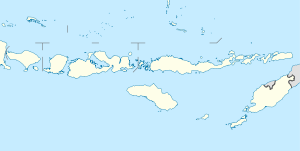Wewiku
| Kecamatan Wewiku Wewiku District
|
|
|---|---|
| Basic data | |
| Country | Indonesia |
| province | East Nusa Tenggara |
| Administrative district | Malaka |
| Seat | Hanemasin |
| Residents | 17,079 (2010) |
| ISO 3166-2 | ID-NT |
Coordinates: 9 ° 43 ′ S , 124 ° 50 ′ E
Location in East Nusa Tenggara Province
|
Wewiku is an Indonesian district ( Kecamatan ) in the south of the island of Timor . It belongs to the Malaka administrative district of East Nusa Tenggara Province .
geography
Wewiku forms the southern tip of the Malaka administrative district. It borders Weliman to the north, Malaka Barat to the northeast , the administrative district of South-Central Timor to the west and the Timor Sea to the south . Until the Malaka Governorate was created on December 14, 2012, Wewiku was part of the Belu Governorate .
Wewiku is divided into the twelve Desa Lamea (1314 inhabitants 2010), Alkani (1702), Seserai (1339), Lorotolus (1428), Weulun (1024), Weoe (4368), Webriamata (1091), Badarai (1556), Halibasar (1102), Weseben (694), Rabasa Biris (732) and Biris (729).
The administrative seat is Hanemasin .
Residents
The majority of the 17,079 inhabitants (2010) speak Tetum Terik .
history
Antonio Pigafetta , a member of the Magellan Expedition , visited Timor briefly in 1522. He reports that there were four main Timorese kings who were brothers: Oibich, Lichisana, Suai and Canabaza . Oibich was the chief of the four. Oibich could be assigned to Wewiku, which is referred to in later sources as the Wehales base . Suai is the capital of what is now the East Timorese community of Cova Lima and probably formed a double empire with Camenaça (Kamenasa, Canabaza, also Camenaça or Camenasse). Lichisana is equated with Liquiçá . Since Lichisana and Suai-Canabaza Wehale were tributary and all of these empires were in the center and east of Timor, the Portuguese later grouped them together as the province of Belu (also: Belos or Behale ). Iron was known, but no script was in use. The population practiced traditional, animistic practices .
On May 26, 1641, the Portuguese military leader Francisco Fernandes defeated a force of the Liurais von Wehale on the border with Mena . The Portuguese then began under Fernandes with a large-scale military operation to extend their control to the interior of the island. The previous Christianization supported the Portuguese in their quick and brutal victory, as their influence on the Timorese had already weakened the resistance. Fernandes carried out the campaign with only 90 Portuguese musketeers. But he was supported by numerous Timorese warriors. He first moved through the area of Sonba'i and until 1642 conquered the kingdom of Wehale, which was considered the religious and political center of the island.
When a Portuguese attack on the Dutch possession of Kupang ended in disaster in 1749, Portuguese rule in West Timor collapsed. Most of the regional rulers signed treaties with the Dutch East India Company in 1756 . Including Jacinto Correa , King of Wewiku-Wehale and Grand Duke of Belu , who also signed the dubious Treaty of Paravicini on behalf of many areas in central Timor , including for Wewiku, which was still part of Wehale's sphere of influence. The area came under Dutch rule, at least nominally. It was not until 1906 that the area of Wehale was finally integrated into the colonial structure of the Dutch, the local ruler remained.
Individual evidence
- ↑ Map of Kebupaten Belu from 2010
- ↑ a b Penduduk Indonesia menurut desa 2010 ( Memento from March 27, 2014 in the Internet Archive ) (Indonesian; PDF; 6.0 MB), accessed on January 26, 2013
- ^ Geoffrey C. Gunn: History of Timor. ( Memento of the original from March 24, 2009 in the Internet Archive ) Info: The archive link was inserted automatically and has not yet been checked. Please check the original and archive link according to the instructions and then remove this notice. , P. 17, Technical University of Lisbon (PDF file; 805 kB).
- ^ History and Politics: 2. b. Portuguese contact and historical experience - Center for Southeast Asian Studies, Northern Illinois University
- ^ Frédéric Durand: Three centuries of violence and struggle in East Timor (1726-2008). (PDF; 243 kB) Online Encyclopedia of Mass Violence, (online), June 7, 2011, accessed on May 28, 2012, ISSN 1961-9898
- ↑ Douglas Kammen: Fragments of utopia: Popular yearnings in East Timor , Journal of Southeast Asian Studies, 40 (2), pp. 385–408 June 2009, doi : 10.1017 / S0022463409000216 .
